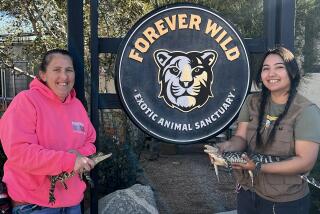Cold Feet in the Delivery Room
- Share via
SAN DIEGO — At 22 degrees Fahrenheit, the delivery room at Sea World may be colder than most, but no less productive.
In fact, more feathered couples than ever are becoming parents at the marine park’s “Penguin Encounter” and their 45 hatchlings are attracting attention.
Lately, the glassed-in, 5,000-square-foot cold climate exhibit has begun to resemble a hospital infant ward, as park visitors strain to get a glimpse of the 14 fast-growing Adelie penguins that are just beginning to venture outside their nests.
But some of the most exciting additions to the park’s penguin colony are not yet on public display. In addition to 23 other Adelie babies, two Gentoo penguins are being hand-raised by park keepers--the first Gentoos to be born from eggs laid in captivity at Sea World. Six baby Humboldt penguins are being hand-raised as well. Keepers say that by observing the young, they hope to learn more about preserving Humboldts, the one penguin species that is endangered.
“If there was an oil spill off the coast of Chile or Peru where the Humboldts are, that could disrupt the whole species,” said Joop Kuhn, supervisor of aviculture at Sea World. “We’d need to know what to feed them, how often, how much. But we’re getting a pretty good understanding--we’d know where to start.”
With more than 500 penguins, the park’s 6-year-old exhibit is the largest penguin colony outside of the Antarctic. As part of a project conducted with the National Science Foundation, the park keeps detailed records on each penguin from nine different species.
There’s a file, for example, on King Tut, the first King penguin park keepers hand-raised from an egg that was laid in the wild. There’s another on Elvis, a King penguin named for the “king of rock and roll,” Kuhn said.
Files include personal details, he said: “Who they’re paired up with, how many offspring they’ve had, if they’ve changed mates--for the most part they’re monogamous, but we’ve seen a slight divorce rate in our enclosure.”
Park experts know which birds have shown a knack for keeping their eggs warm, and which have wandered off to let the eggs fend for themselves. They know when a penguin lays two eggs, as they often do as a kind of “insurance,” Kuhn said.
“Most penguin species will lay two eggs but rarely will they be able to raise both young. It’s survival of the fittest,” he said.
But park keepers, eager to supplement their growing colony, have begun rescuing the second eggs from the nests before they hatch.
“Mother Nature is very tough on her own. We try to sort of soften that by artificial incubating,” Kuhn said. “If we take one egg from our birds, and leave them with one, they will put all their effort and energy there.”
The hand-raised babies are treated to what keepers call penguin milkshakes, a tasty mixture of herring filets, shrimp-like crustaceans, half-and-half cream, water and vitamins that is heated to 90 degrees to resemble the regurgitated meals their parents would feed them in the wild, Kuhn said.
Kuhn said the park had also hoped to hatch some Chinstrap penguins this year, which have never been hatched in captivity. Chinstrap penguins, named for the black stripe across their necks, laid eggs for the first time at Sea World this year. But the eggs proved infertile.
“They do their best sitting on the eggs. Hopefully by the second year . . . they can pull it off,” Kuhn said.
More to Read
Sign up for The Wild
We’ll help you find the best places to hike, bike and run, as well as the perfect silent spots for meditation and yoga.
You may occasionally receive promotional content from the Los Angeles Times.






